Deauville – Stemware with the Same Design in its Stem and its Etching
by Les Hansen
Issue No. 463 - November/December 2012
The Cambridge stemware line #3125 is unique in many ways. Design patent applications were filed in December 1931 by the Cambridge Glass Company for the stemware. However, when granted, the patents were assigned to Oneida Community Limited, Oneida, NY, which is the well-known silver-plating company that continues to make flatware (silverware) to this day. So, no, Cambridge didn't own the patent for this line of stemware that it produced.
The reason for this unusual situation is stemware line #3125 was developed to match an existing design used by Oneida Community on flatware, china, and hollowware (silver-plated items). The Deauville design is molded directly into Cambridge #3125 stemware, which has a four-sided stem, and the Deauville design is also etched on the bowls of this Cambridge stemware line.
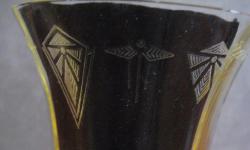 Actually, the etching on the bowls has three design patterns that are illustrated in the first photo. The largest of the three designs is the key one, which is on the left in the photo and is molded into all four sides of the stem and, also, is the singular design used on the flatware. Definitely, this design is the epitome of Art Deco, which was the rage internationally following its launch in Paris, France, in the 1920s. With its sharp, angular lines, Art Deco continued as a major design influence internationally well into the 1930s and experienced numerous revivals. The triangular designs in the spire at the top of the Chrysler Building in Manhattan, New York, are highly reminiscent of Deauville.
Actually, the etching on the bowls has three design patterns that are illustrated in the first photo. The largest of the three designs is the key one, which is on the left in the photo and is molded into all four sides of the stem and, also, is the singular design used on the flatware. Definitely, this design is the epitome of Art Deco, which was the rage internationally following its launch in Paris, France, in the 1920s. With its sharp, angular lines, Art Deco continued as a major design influence internationally well into the 1930s and experienced numerous revivals. The triangular designs in the spire at the top of the Chrysler Building in Manhattan, New York, are highly reminiscent of Deauville.
The word "Deauville" originates where? Logically, it has its origins in France . as did the Art Deco movement. Deauville (pronounced doé-vill in English and doe-veal´ in French) is a resort beach town on the English Channel (northern coast) of Normandy, France. It is located on the eastern edge of the beaches used for the Allied Invasion of Normandy. Today, Deauville is a highly fashionable destination for the rich and famous with 5-star hotels, casinos, and a horse racetrack. It is the closest beach town to metropolitan Paris.
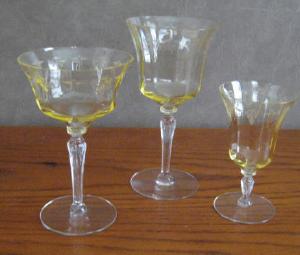 In the book, Cambridge Stemware, author Mark Nye states the following about #3125 Deauville stemware:
In the book, Cambridge Stemware, author Mark Nye states the following about #3125 Deauville stemware:
"Since the design patents covering both the stemware and the etching were assigned to Oneida, it is entirely possible Cambridge never sold this line directly. Instead, they may have produced it for Oneida, who in turn used it promote their [Deauville] flatware line. The ... etching plates for this line do not have on them a name or number for the etching. [Therefore, we have] assigned the name Deauville to the etching. Likewise, ... Deauville has been assigned to the stemware ... since the [Deauville design] is molded into the stem. There is no indication Cambridge used [Deauville] to identify #3125 stemware."
Therefore, "Deauville" has been assigned to both the #3125 stemware and the etching found on it, because there is no evidence Cambridge used a name for either the stemware or the etching. Definitely, the design (found on both the #3125 stemware and its etching) were developed to match the Deauville flatware, hollowware, and china marketed by Oneida.
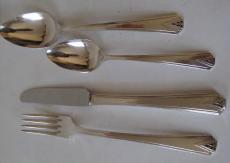 All known examples of Deauville (#3125) stemware by Cambridge have a Gold Krystol optic bowl with a crystal stem and foot and contain the Deauville etching. Only four blanks have surfaced to date: goblet, tall sherbet, 12 oz. footed tumbler, and 5 oz. footed tumbler.
All known examples of Deauville (#3125) stemware by Cambridge have a Gold Krystol optic bowl with a crystal stem and foot and contain the Deauville etching. Only four blanks have surfaced to date: goblet, tall sherbet, 12 oz. footed tumbler, and 5 oz. footed tumbler.
Deauville was one of numerous design patterns used on the flatware (silverware) produced by Oneida in its "Community" line. Introduced in 1929, the Deauville design on flatware was produced until at least 1937. Also, Oneida produced matching silver hollowware pieces, such a full tea service (pot, cream, & sugar), salt & pepper shakers, trays, and candlesticks. The history of the Community line by Oneida, including Deauville, was well documented by Nancy Gluck in her publication (available in a 3-ring binder) called The Community Table.
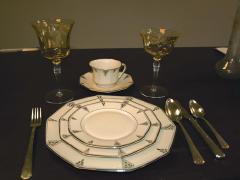 Notably, Oneida began selling fine china to match the Deauville flatware in 1931. The china must have, likewise, been a popular seller, because it is plentiful in today's resale market. The Deauville design on the china is in platinum on a cream-colored background, and the plates are 8-sided. The vast majority of Deauville china was produced in Bavaria, Germany, which is cleared marked on the underside of each piece. A small amount of Deauville china is marked Limoges, France, and the Limoges china is whiter in color than the creamy-colored china made in Bavaria. Consequently, all Deauville china marketed by Oneida was imported from Germany or France.
Notably, Oneida began selling fine china to match the Deauville flatware in 1931. The china must have, likewise, been a popular seller, because it is plentiful in today's resale market. The Deauville design on the china is in platinum on a cream-colored background, and the plates are 8-sided. The vast majority of Deauville china was produced in Bavaria, Germany, which is cleared marked on the underside of each piece. A small amount of Deauville china is marked Limoges, France, and the Limoges china is whiter in color than the creamy-colored china made in Bavaria. Consequently, all Deauville china marketed by Oneida was imported from Germany or France.
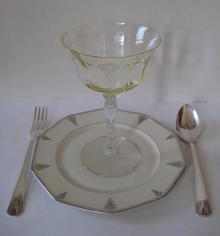 Apparently, Oneida was enterprising and decided to add stemware to the flatware, hollowware, and china lines with the Deauville design that they were already promoting. This explains the design patent application in December 1931 for matching stemware to be produced by Cambridge. A 1932 Oneida advertisement contains a photograph with a Cambridge #3125 Deauville goblet (with Gold Krystol optic bowl) in combination with the Deauville china (creamy-colored with platinum decoration) and silver flatware. The optic bowl of the Gold Krystol #3125 stemware nicely complements the 8-sided creamy-colored china plates.
Apparently, Oneida was enterprising and decided to add stemware to the flatware, hollowware, and china lines with the Deauville design that they were already promoting. This explains the design patent application in December 1931 for matching stemware to be produced by Cambridge. A 1932 Oneida advertisement contains a photograph with a Cambridge #3125 Deauville goblet (with Gold Krystol optic bowl) in combination with the Deauville china (creamy-colored with platinum decoration) and silver flatware. The optic bowl of the Gold Krystol #3125 stemware nicely complements the 8-sided creamy-colored china plates.
The production period of the #3125 stemware by Cambridge was very brief – perhaps, limited to 1932, with some potential for spillover to 1931 and 1933. By 1933, Oneida made no mention of the #3125 stemware made by Cambridge but, instead, was marketing
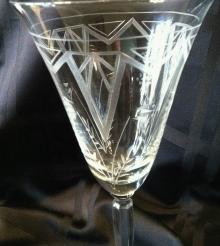 stemware that was wheel-cut with the triangular Deauville design. The cut stemware was featured in Oneida advertisements in 1933, 1934, and 1937. Therefore, a switch from the #3125 stemware with an etching by Cambridge to the stemware with a cutting took place sometime during 1932 or 1933. The Deauville cut stemware was available in all-crystal, crystal bowl & foot with a green stem, and all-green, but the vast majority that surfaces today is all-crystal.
stemware that was wheel-cut with the triangular Deauville design. The cut stemware was featured in Oneida advertisements in 1933, 1934, and 1937. Therefore, a switch from the #3125 stemware with an etching by Cambridge to the stemware with a cutting took place sometime during 1932 or 1933. The Deauville cut stemware was available in all-crystal, crystal bowl & foot with a green stem, and all-green, but the vast majority that surfaces today is all-crystal.
Who produced the stemware with the Deauville cutting? We don't know. The stemware with the Deauville cutting was complemented by a water pitcher (jug), a finger bowl, and a salad plate that each had the Deauville cutting. The water pitcher is a blank documented to have been produced by Morgantown. However, the cut Deauville stemware has incredibly generic shapes – both the bowl and the stem; therefore, firm attribution isn't possible without supporting documentation. The shape of the both the stem and the bowl of the cut Deauville stemware is very reminiscent of #3138 of Cambridge (introduced in 1937), and the stem is sometimes referred to as "lady leg." Perhaps, all of the stemware with the Deauville cutting is on blanks produced by Morgantown. Another possibility is Oneida contracted with a cutting firm to wheel-cut the Deauville design on blanks produced by multiple glass companies. We may never know.
